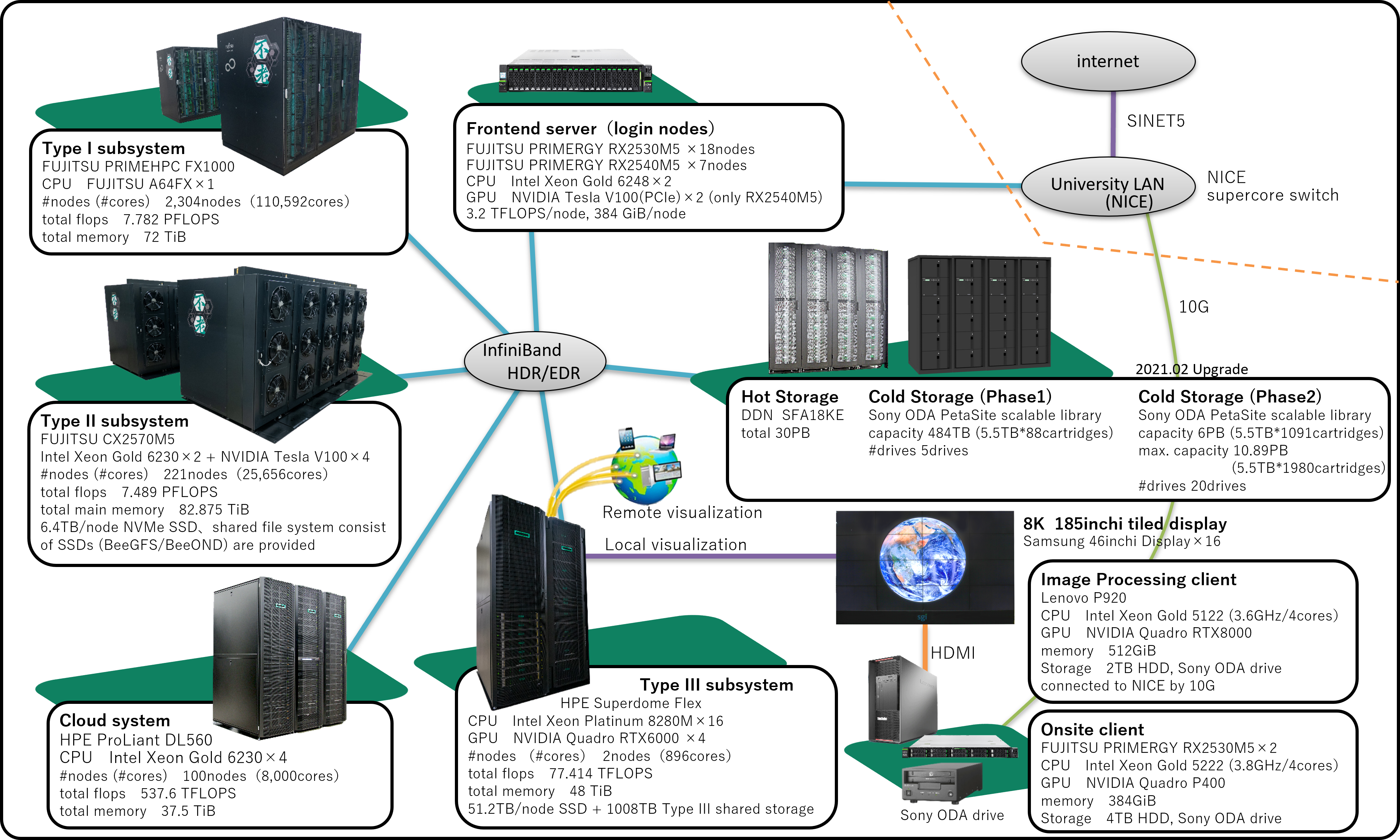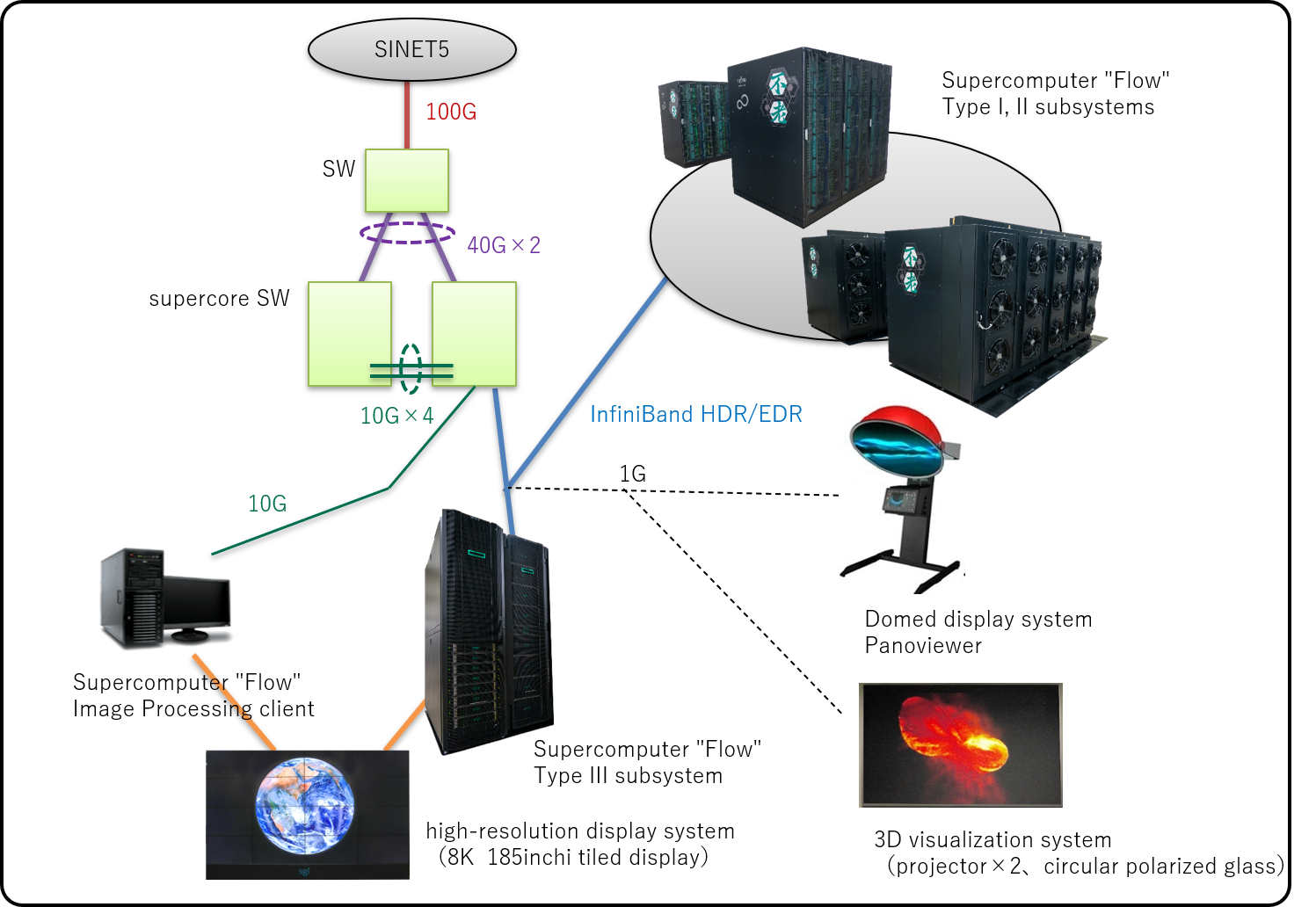Supercomputer
The Information Technology Center at Nagoya University began with the general purpose computer Fujitsu FACOM230-60 in 1971. A supercomputer was first installed in 1987 and has since been used by a number of researchers in the field of scientific computing. We installed the new-system Supercomputer "Flow" and started computing services in July 2020. We support academic research at a wide range of universities and other institutes by supplying services such as computing that accommodates researcher demand for large-scale computing, "Post Processing" to enable visualization, computer statistics, big data mining, "Data Intensive Computing" to provide new services in distributed data processing, distributed databases, and small virtual computers for laboratories. As a partner institute in the Joint Usage/Research Center (JHPCN) in Japan since 2010, we have played a role in the research and development of high-performance computing technology.
Furthermore, since 2010, we have participated in a joint research project in cooperation with the Institute for Space-Earth Environmental Research (ISEE) at Nagoya University to promote academic research and advanced technology in high-performance computing in fluid, plasma, machine learning, and general computational science. Moreover, since 2012, we have worked as resource providers for the High Performance Computing Infrastructure (HPCI) in Japan, helping to accelerate a wide range of HPC utilization from exploratory research to large-scale and industrial research, to enlarge and foster the computational science community, and to utilize the best achievements for the good of society by matching needs and available resources on a nationwide scale.
Information
- 2024.11.07 【Event】 Nagoya University at SC24 exhibits in Atlanta, GA, November 18 - 21, 2024
- 2023.11.07 【Event】 Nagoya University at SC23 exhibits in Denver, CO, November 13 - 16, 2023
- 2020.11.24 【Event】 Nagoya University made a virtual exhibit at SC20 (Posters and Videos are available)
- 2020.07.01 Supercomputer "Flow" started computing service.
- 2020.04.07 Information of new system Supercomputer "Flow" is disclosed.
- 2019.10.29 【Event】 Nagoya University will exhibited at SC19 in Denver, CO, November 18 - 21, 2019
History of ITC-NU



















- 1971 Nagoya University established Computation Center (NUCC), and installed Fujitsu FACOM 230 series for national joint use.
- 1979 NUCC began computing services using Fujitsu FACOM M series.
- 1987 NUCC acquired Fujitsu FACOM VP series of the vector supercomputer, and launched high‐performance computing service.
- 1995 NUCC updates supercomputer to Fujitsu FACOM VPP series. VPP500/42 was ranked 12th in the 6th TOP500 list (1995, Dec.), and VPP5000/56 was ranked 25th in the 7th TOP500 list (1996, Jun.).
- 2000 Fujitsu GP7000F/90, NUCC's first SPARC64 system, was installed.
- 2002 NUCC was reorganized into the Information Technology Center, Nagoya University (ITC‐NU).
- 2005 ITC‐NU installed a scalar‐type supercomputer system, Fujitsu HPC2500 with a peak performance of 14 Tflops. It was ranked 41th in the 25th TOP500 list (2005, Jun.).
- 2009 For diversified computing demand, ITC‐NU installed Fujitsu HX600 by T2K open supercomputer specification, and Fujitsu M9000 of large SMP system. ITC‐NU installed Fujitsu FX1 with a peak performance of 30 Tflops.
- 2010 ITC-NU is certified as one of the Joint Usage/Research Center for Interdisciplinary Large-scale Information Infrastructures (JHPCN).
- 2013 ITC‐NU installed Fujitsu FX10 with a liquid‐cooled system, and a petabyte-scale distributed storage system. Fujitsu CX400, oome of the nodes equip many-core co-processor (KNC) was installed.
- 2014 ITC‐NU launched Visualization Lab with SGI UV2000 and an 8K tiled display system.
- 2015 ITC‐NU updated the supercomputer system to Fujitsu FX100 with a peak performance of 3.2 Pflops. FX100 was ranked 21st in the 46th TOP500 list (2015, Nov.), and also 12th in HPCG (2015, Nov.).
- 2020 To meet the increasing computational demand on both large‐scale numerical simulation and data science, ITC‐NU installed Supercomputer "Flow", a complex supercomputer system, consisting of four compute subsystems and two storage systems with the total peak performance of 15.9 Pflops.
Supercomputer "Flow" System Overview
Supercomputer "Flow" consists of four computing subsystems and two storage systems. Total theoretical peak performance is 15.88 PFLOPS. Users can use all subsystems by one account. Computing service has begun on July 1st, 2020.
Type I subsystem

The world's first regular service of "Fugaku" type system. Useful for programs developed on "K", FX10, and FX100.
- FUJITSU Supercomputer PRIMEHPC FX1000
- A64FX CPU * 1, 2,304 nodes
- 3.3792 TFLOPS * 2,304 nodes = 7.782 PFLOPS
Type II subsystem

Our first large scale GPU system. Suitable for data science, machine learning, and AI researches.
- FUJITSU Server PRIMERGY CX2570 M5
- Intel Xeon CPU * 2 + NVIDIA V100 GPU * 4, 221 nodes
- 33.888 TFLOPS * 221 nodes = 7.489 PFLOPS
- 6.4TB/node SSD available, also providing local shared storage (BeeGFS/BeeOND/NVMesh)
Type III subsystem
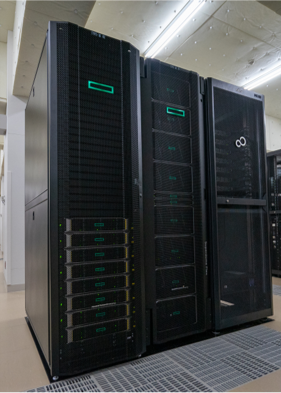
Huge size memory system. Suitable for large scale pre-/post-processing and visualization.
- HPE Superdome Flex
- Intel Xeon CPU * 16+ NVIDIA Quadro RTX6000 * 4, 2 nodes
- 24TiB huge size memory / node
- connected to visualization systems
Cloud system

Supporting both traditional batch job and time appointing batch/interactive job.
- HPE ProLiant DL560
- Intel Xeon CPU * 4, 100 nodes
- 5.376 TFLOPS * 100 nodes = 537.6 TFLOPS
Storage system

Consists of 30 PB HDD RAID storage (Hot storage) and optical disk archive system for long-term data archival (Cold storage).
- Hot storage: FUJITSU PRIMERGY RX2540 M5 / ETERNUS AF250 S2 + DDN SFA18KE / SS9012
- 30PB、RAID6、FEFS
- Cold storage: Sony PetaSite scalable library
- 6 PB/Max 10.89 PB
Visualization system
HPCI and JHPCN
Nationwide Joint-use Systems
Information Technology Center (ITC), Nagoya University is providing large-scale computing resources to nationwide researchers as a Joint Usage / Research Center, which is admitted by Ministry of Education, Culture, Sports, Science and Technology, Japan.
HPCI
HPCI establishes a high performance computing infrastructure that consists of main supercomputers, such as "Fugaku", supercomputers in universities and institutes, with an academic network to satisfy wider requirements from users. The supercomputers in ITC, Nagoya University are also one of the HPCI resources.
JHPCN
The Joint Usage / Research Center for Interdisciplinary Large-scale Information Infrastructures (JHPCN) is made up of eight centers equipped with supercomputers. This is a network-type joint usage and collaborative research center, and its core institution is the Information Technology Center of the University of Tokyo.
JHPCN accepts submissions of collaborative researches and its reviewing and acceptance in 4 kinds of research field for very large-scale computations.
Interdisciplinary collaborative researches are performed with tightly collaboration between applicants and faculties of JHPCN centers.
HPCI Resources
Research Results by using Supercomputers in ITC, Nagoya U.
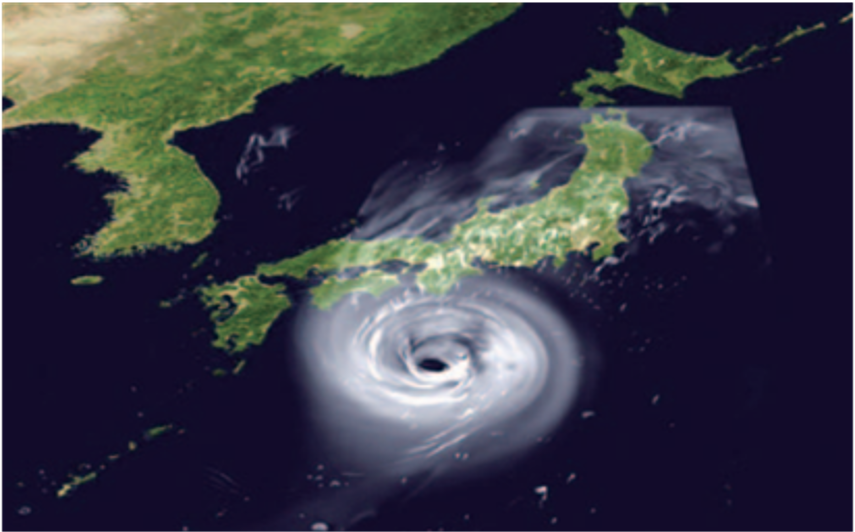 Weather simulation using the CReSS
Provided by Kazuhisa Tsuboki, Institute for Space-Earth Environmental Research (ISEE), Nagoya University
Weather simulation using the CReSS
Provided by Kazuhisa Tsuboki, Institute for Space-Earth Environmental Research (ISEE), Nagoya University
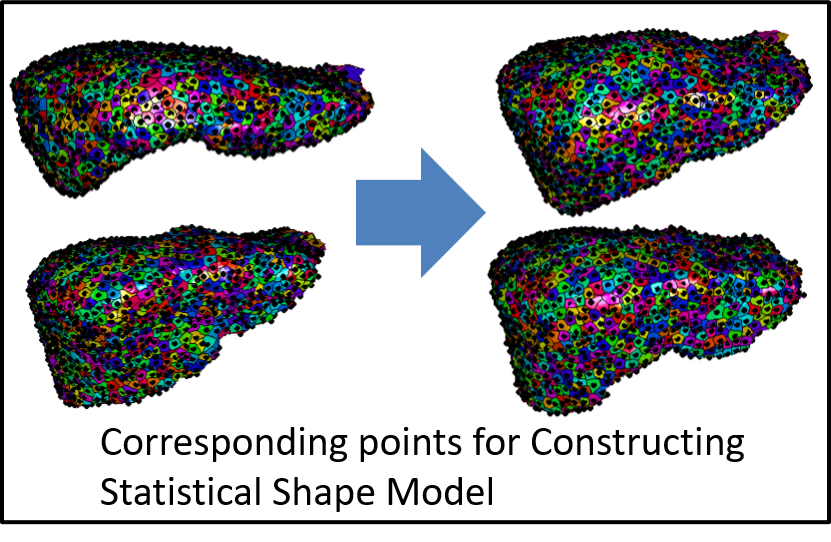 High Speed Computation of Large Deformation Diffeomorphic Metric Mapping of Abdominal Organs
Provided by Hidetaka Hontani, Department of Computer Science, Nagoya Institute of Technology
High Speed Computation of Large Deformation Diffeomorphic Metric Mapping of Abdominal Organs
Provided by Hidetaka Hontani, Department of Computer Science, Nagoya Institute of Technology
 Fragment molecular orbital based interaction analyses on COVID-19 main protease
Provided by Yuji Mochizuki, Department of Chemistry,Rikkyo University
Fragment molecular orbital based interaction analyses on COVID-19 main protease
Provided by Yuji Mochizuki, Department of Chemistry,Rikkyo University
 Simulation of auroral turbulence in the magnetosphere-ionosphere coupling system
Provided by TomoHiko Watanabe, Department of Physics, School of Science Nagoya University
Simulation of auroral turbulence in the magnetosphere-ionosphere coupling system
Provided by TomoHiko Watanabe, Department of Physics, School of Science Nagoya University
 Lung segmentation from CT volume with AI
Provided by Kensaku Mori, Department of Intelligent Science, Nagoya University
Lung segmentation from CT volume with AI
Provided by Kensaku Mori, Department of Intelligent Science, Nagoya University




